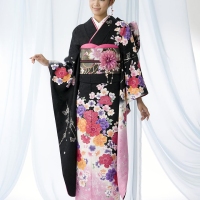
Voor een Nederlandse vertaling: Scroll naar beneden
Origami (折り紙), Japanese: ‘ori’ means to fold and ‘kami’ paper, is a traditional Japanese folding art and developed in the Edo period.
Origami uses a limited number of folds but due to the combination of these folds intriguing designs are possible. The art originates in China during the first or second century, shortly after the invention of paper. From China it came to Japan, where it gained its shape and form as we know it today. In general the designs start with a piece of squared paper of which the sides can be differently colored. The paper may be fold but it cannot be cut.
Japanese origami has been applied since the Edo period (1603-1867). Although frequently assumed, Japanese origami can also be made with a rectangular piece of paper instead of a squared one.
origami as a secret art for the Noble
The Japanese are said to be good at handcrafted work. Of course, there are always exceptions but in general children in kindergarten can already fold a crane bird or helmet. A foreigner completely ignorant regarding origami will be very impressed by the many possibilities one can make out of a single piece of paper.
Simple origami erects from the time of Prince Shoutokutashi (572-622) when the method of produce was first introduced by the Korean priest Tan Zhi. Traditionally de acts of ‘break’, ‘fold’ and ‘bind’ were linked to religious ceremonies. In these days people came up with certain rules concerning the folding of paper because this form of folding art was being used during formal and, most of all, holy occasions.
family secret
During the Muromachi period (1333-1568), when the shogun laid down several rules and laws, the Ogasawara and Ise families were responsible for the rules regarding ceremonial ornaments (made out of paper) and gift wraps. They decided that the rules could only be passed on as a family secret and strictly to a select number of people.
gift wrapping
During this period it was important that, if a gift was to be wrapped, it was easy to guess what it contained by the way it was packed. In other words, the package had to clearly show the form of the object inside or there had to be a small opening so one could peek inside. If it was a small gift, the giver had to write down a description of the content including the quantity.
1000 crane birds for good luck
During the Edo Period a book was published which reflected 49 ways of folding a crane bird. From that time on the tradition of folding a 1000 crane birds for luck, began to arise. This was done when, for example, someone was ill or was going to make a great journey. A crane bird is supposed to deliver a blessed feeling, therefore a 1000 or more should give you enough to be quite alright.
Mid-Meiji Period people started to teach children to fold origami in order for them to learn about art in a playful manner.
magical origami
The first person to introduce origami in Europe was a magician. In that time balloons were not yet invented so no balloon animals could be crafted. Therefore, this magician gave children joy by making them an animal of origami. He used the origami technique as well during his shows and the crowd was very impressed by his capability of crafting 3D figures out of a single piece of paper.
origami after WWII
After the Second World War the soldiers brought the art of folding back to the United States and there as well it became a huge success. Many of the more unique designs of origami which are invented in this period, were made by foreigners. After all, the Japanese had to obey strict rules that did not influence nor impede the designs of foreigners. They could fold whatever fantasy they imagined and therefore created many more creative forms. This freedom eventually reached Japan as well and they decided to ditch the rules and give their imagination free rein.
“origamians”
Official practitioners of origami are called Origamians and are a phenomenon all over the world. There are even competitions where participants are being challenged to great new creative pieces and push the boundaries of Origami.
geometrical imagination
During the Showa Period (1926-1989) Origami was seen as inferior to kids in kindergarten because it would limit the free imagination and fantasy. A chemist called Ryuutarou Tsuchida and Kouji Fuhimi, a physicist, spread around that Origami was actually good for children in their development phase. The creation of many complicated forms stimulates the geometrical imagination and will prepare children to solve difficult mathematical problems later on in high school. These two geniuses thought that children who learn to think with their spatial skills by making Origami, will be able to apply this way of thinking at mathematics while children who have never created Origami will have much more trouble in this area.
origami in space
Nowadays Origami is even applied in space. The technique is used to fold a solar panel. Professor Kouryou developed the Muira-ori method. This is an ideal way to fold a solar panel in space, for it to be as effective in space as possible. This Muira-ori method has ever since been applied to many more utilizations. Origami has been proved to be ideal for all ages. It can provide hours of joy but also improve science and technology.
Want to learn the art of Origami by an expert?
Surf to: www.shoko-origami.com for more information.
NEDERLANDSE VERTALING:
Origami (折り紙), Japans: ‘ori’, vouwen, en ‘kami’, papier is een traditionele Japanse vouwkunst en is ontstaan in de Edo periode.
Origami gebruikt een beperkt aantal vouwen, maar door de combinatie hiervan zijn intrigerende ontwerpen mogelijk. De kunst stamt uit China in de eerste of tweede eeuw, kort na de uitvinding van het papier. Van daar uit is het overgewaaid naar Japan, waar het de bekende vorm heeft gekregen. In het algemeen beginnen deze ontwerpen met een vierkant stuk papier, waarvan de zijdes verschillend gekleurd kunnen zijn. Het papier mag wel gevouwen worden maar er mag niet in geknipt worden.
Japans origami wordt dus al toegepast sinds de Edoperiode (1603-1867). In tegenstelling met wat algemeen wordt aangenomen, wordt in de Japanse origami soms ook met rechthoekig en rond papier gewerkt.
origami als een geheime kunst voor de nobelen
Van Japanners wordt gezegd dat ze goed zijn in handwerk. Natuurlijk zijn er altijd uitzonderingen, maar over het algemeen kunnen kinderen vanaf de kleuterschool al een kraanvogel of een helm vouwen. Een buitenlander die
niets weet van origami, zal onder de indruk zijn van wat je allemaal kunt maken uit 1 velletje papier.
Simpele origami stamt al uit de tijd van de prins Shoutokutashi (572-622) toen de methode voor het produceren voor het eerst werd geÏntroduceerd door de Koreaanse priester Tan Zhi. Traditioneel gezien waren de handelingen van ‘breek’, ‘vouw’ en ‘binden’ gelinkt aan religieuze ceremonies. In deze tijd bedachten de mensen al bepaalde regels voor het vouwen van papier aangezien deze vorm van vouwkunst destijds werd gebruikt tijdens formele en vooral ook heilige gelegenheden.
familiegeheim
In de Muromachi periode (1333-1568), toen de shogun allerlei wetten en regels vast stelde, waren de Ogasawara en de Ise familie verantwoordelijk voor de regels omtrend ceremoniële ornamenten (gemaakt van gevouwen papier)en cadeauverpakkingen. Zij stelden dat de regels alleen doorgegeven mochten worden als familiegeheim en alleen aan een select aantal personen.
kadootjes inpakken
In deze periode was het van belang dat als een cadeau werd ingepakt, het door de wijze van verpakken gemakkelijk te raden was wat er in zat. Ofwel het pakje moest duidelijk de vorm tonen van hetgeen erin zat, of er moest een kleine opening worden open gelaten zodat men naar binnen kon gluren. Als het een klein kadootje was, dan moest de gever een omschrijving van de inhoud op de verpakking schrijven plus de hoeveelheid.
1000 kraanvogels voor geluk
Tijdens de Edo periode werd er een boek gepubliceerd die 49 verschillende manieren weergaf hoe je een kraanvogel kunt vouwen. Vanaf die tijd begon ook de traditie om 1000 kraanvogels te vouwen voor geluk, bijvoorbeeld als iemand ziek was of een lange reis zou gaan maken. Een kraanvogel zou een gelukzalig gevoel moeten brengen, dus als er 1000 of meer zijn, dan moet het wel goed komen met je.
Tijdens het midden van de Meiji periode begon men met het leren van origami aan kinderen om hen op een speelse manier artistieke kunst bij te brengen.
magische origami
De eerste persoon die Origami in Europa introduceerde was een googelaar. In die tijd hadden ze nog geen ballonnen om ballonbeesten van te maken, dus maakte deze ‘magiër de kinderen die toestroomden blij met een beestje gemaakt van Origami. Hij gebruikte de Origami techniek ook tijdens zijn shows en zijn publiek was bijzonder onder de indruk dat hij de meest fantastische 3D vormen uit een enkel blaadje papier wist te krijgen.
origami na WWII
Na de Tweede Wereldoorlog brachten de soldaten de kunst van het vouwen terug naar de Verenigde Staten en werd het ook daar een groot succes. Veel van de meer unieke Origami kunstwerkjes die in deze periode zijn ontworpen, waren gemaakt door buitenlanders. Japanners moesten zich immers aan strikte regels houden, maar buitenlanders werden hier niet door gehinderd en konden hun fantasie de vrije loop laten, waardoor de meer creatievere vormen buiten Japan ontstonden. Deze beweging bleek een stimulans te zijn voor Japan. Hier werd ook eindelijk besloten de regels overboord te gooien en simpelweg de fantasie de vrije loop te laten.
“origamians”
Officiële beoefenaars van Origami worden Origamians genoemd en is in de hele wereld een fenomeen. Er zijn zelfs wedstrijden waar deelnemers worden uitgedaagd om nieuwe creatieve werkstukken te verzinnen die de grenzen van wat mogelijk is met Origami opzoeken.
geometrische verbeelding
Tijdens de Showa periode (1926-1989) werd Origami als ongeschikt beschouwd voor kinderen die naar de kleuterschool aan omdat het de vrije verbeelding en fantasie zou beperken. Een chemicus, Ryuutarou Tsuchida genaamd en Kouji Fushimi die werkzaam was als natuurkundige, zeiden dat Origami juist goed was voor kinderen in de ontwikkelingsfase. Het maken van de vaak ingewikkelde vormen zorgt ervoor dat de geometrische verbeelding wordt gestimuleerd en zal kinderen voorbereiden om de ingewikkelde wiskunde die ze later op de middelbare school moeten doen. Deze twee knappe koppen meenden dat kinderen die ruimtelijk leren denken door het maken van Origami, zullen deze denkwijze gemakkelijker kunnen toepassen op ingewikkelde wiskundige problemen, terwijl kinderen die nog nooit Origami hebben gemaakt, hier meer moeite meer zullen hebben.
origami in de ruimte
Tegenwoordig wordt Origami zelfs in de ruimte toegepast. De techniek wordt gebruikt om een zonnepaneel op te kunnen vouwen. Professor Kouryou ontwikkelde de Muira-ori methode. Dit is de ideale manier om een
zonnepaneel in de ruimte op te vouwen, zodat het zo effectief mogelijk kan werken in de ruimte. Deze Muira-ori methode heeft inmiddels vele andere toepassingen gevonden. Origami is dus ideaal voor jong en oud. Het zorgt voor urenlang vermaak, maar kan ook zorgen voor een rijk belegde boterham!
Origami leren van een expert?
Kijk dan eens op www.shoko-origami.com voor meer informatie





































